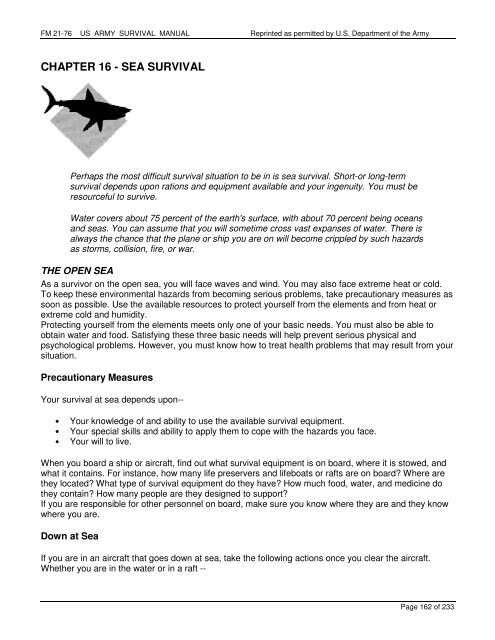FM 21-76 US ARMY SURVIVAL MANUAL
You also want an ePaper? Increase the reach of your titles
YUMPU automatically turns print PDFs into web optimized ePapers that Google loves.
<strong>FM</strong> <strong>21</strong>-<strong>76</strong> <strong>US</strong> <strong>ARMY</strong> <strong>SURVIVAL</strong> <strong>MANUAL</strong> Reprinted as permitted by U.S. Department of the Army<br />
CHAPTER 16 - SEA <strong>SURVIVAL</strong><br />
Perhaps the most difficult survival situation to be in is sea survival. Short-or long-term<br />
survival depends upon rations and equipment available and your ingenuity. You must be<br />
resourceful to survive.<br />
Water covers about 75 percent of the earth's surface, with about 70 percent being oceans<br />
and seas. You can assume that you will sometime cross vast expanses of water. There is<br />
always the chance that the plane or ship you are on will become crippled by such hazards<br />
as storms, collision, fire, or war.<br />
THE OPEN SEA<br />
As a survivor on the open sea, you will face waves and wind. You may also face extreme heat or cold.<br />
To keep these environmental hazards from becoming serious problems, take precautionary measures as<br />
soon as possible. Use the available resources to protect yourself from the elements and from heat or<br />
extreme cold and humidity.<br />
Protecting yourself from the elements meets only one of your basic needs. You must also be able to<br />
obtain water and food. Satisfying these three basic needs will help prevent serious physical and<br />
psychological problems. However, you must know how to treat health problems that may result from your<br />
situation.<br />
Precautionary Measures<br />
Your survival at sea depends upon--<br />
• Your knowledge of and ability to use the available survival equipment.<br />
• Your special skills and ability to apply them to cope with the hazards you face.<br />
• Your will to live.<br />
When you board a ship or aircraft, find out what survival equipment is on board, where it is stowed, and<br />
what it contains. For instance, how many life preservers and lifeboats or rafts are on board? Where are<br />
they located? What type of survival equipment do they have? How much food, water, and medicine do<br />
they contain? How many people are they designed to support?<br />
If you are responsible for other personnel on board, make sure you know where they are and they know<br />
where you are.<br />
Down at Sea<br />
If you are in an aircraft that goes down at sea, take the following actions once you clear the aircraft.<br />
Whether you are in the water or in a raft --<br />
Page 162 of 233





